Business in Practice: Types of Companies, Structures, and Analysis
VerifiedAdded on 2022/12/27
|10
|2955
|55
Report
AI Summary
This report, prepared for a business analysis role, provides a comprehensive overview of different business types and organizational structures. It begins by defining and illustrating micro, small, medium, and large business entities, detailing their characteristics and examples. The report then explores various business ownership structures, including sole proprietorships, partnerships, limited liability businesses, public limited liability businesses, and cooperatives, outlining their definitions, characteristics, and examples. Furthermore, the report examines different organizational structures, explaining how these structures influence business productivity. The report uses J Sainsbury Plc as a case study, applying a PESTEL analysis to identify external factors impacting the organization, such as political, economic, social, technological, environmental, and legal factors. The report concludes by summarizing the key findings and implications for business operations and strategy.
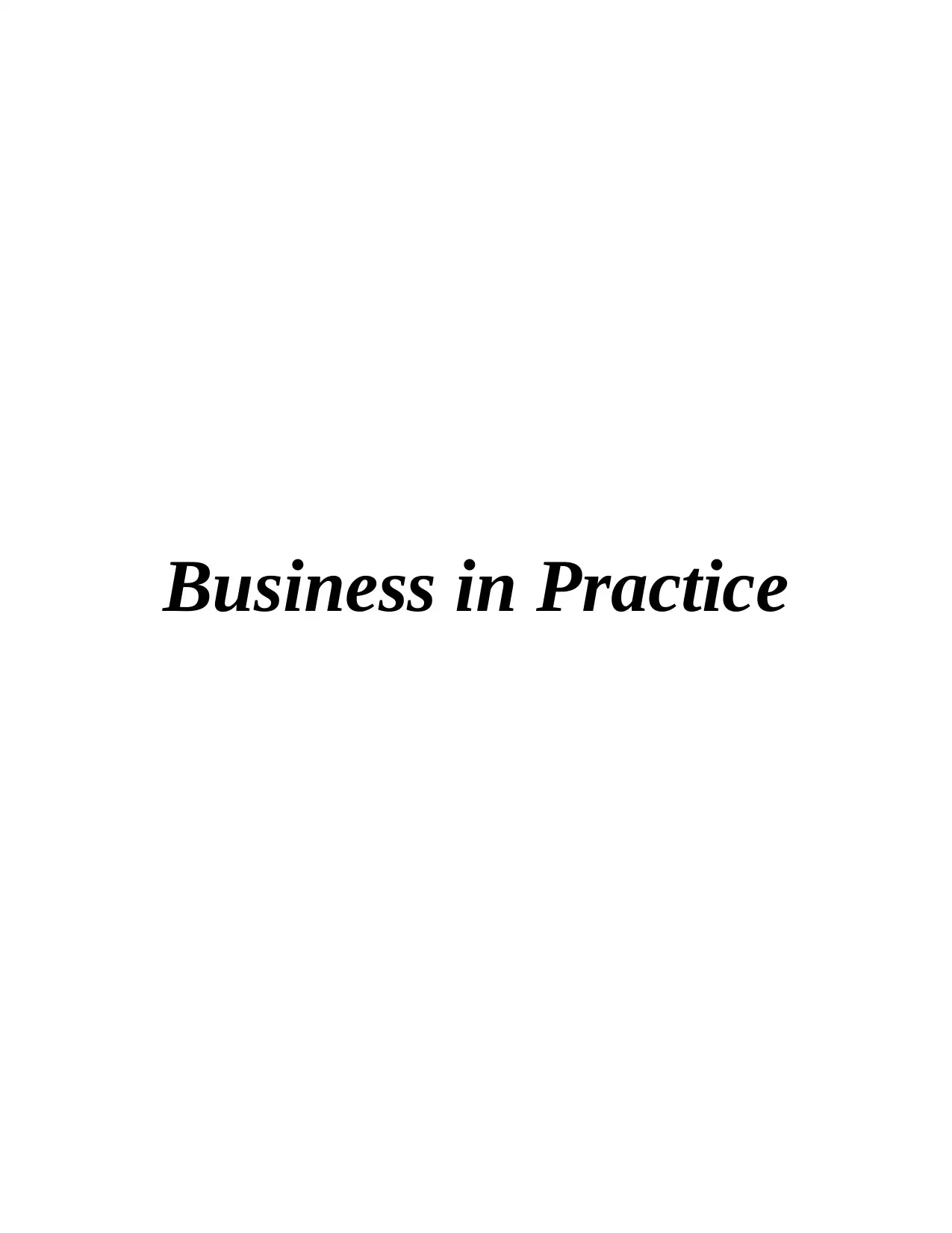
Business in Practice
Paraphrase This Document
Need a fresh take? Get an instant paraphrase of this document with our AI Paraphraser
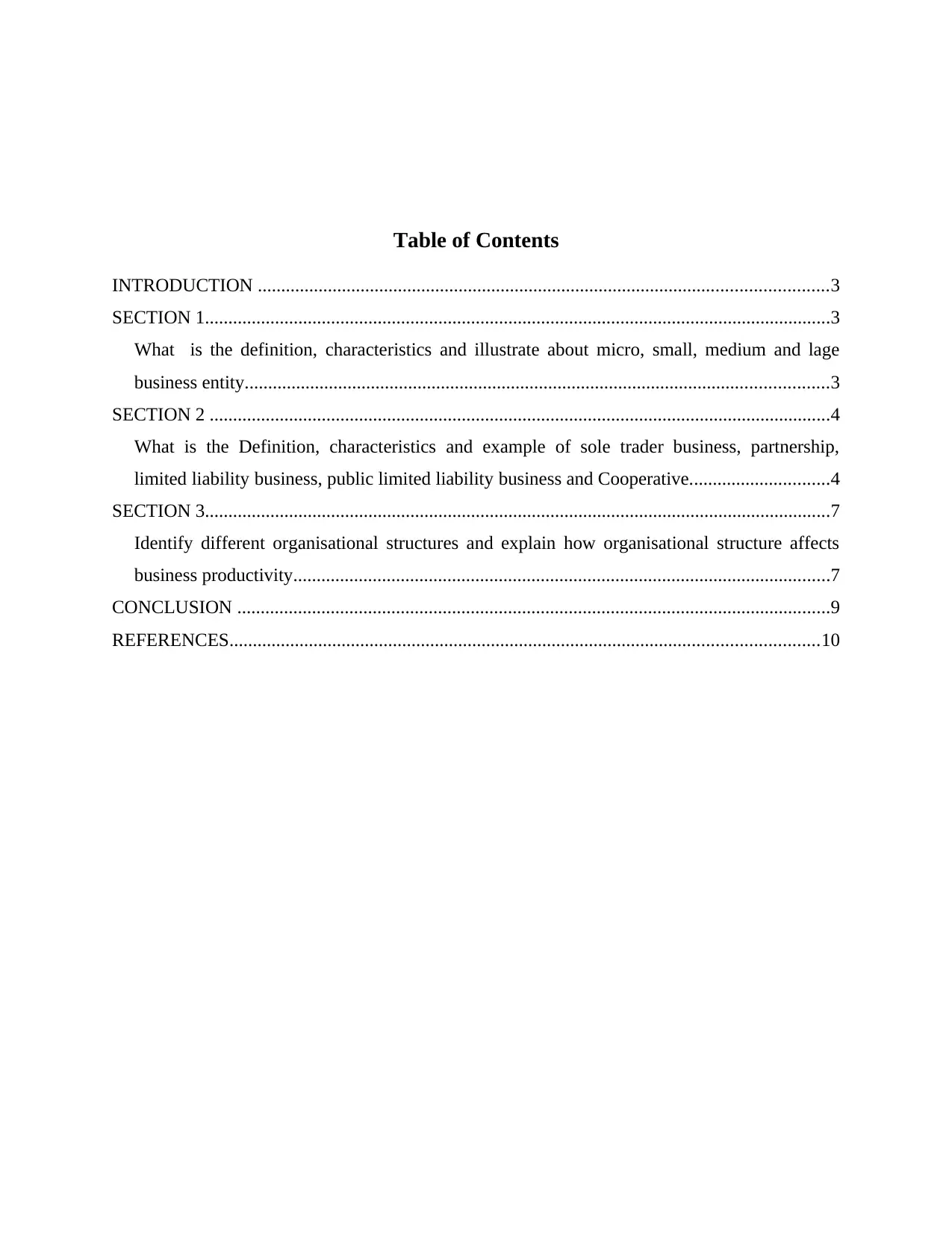
Table of Contents
INTRODUCTION ..........................................................................................................................3
SECTION 1......................................................................................................................................3
What is the definition, characteristics and illustrate about micro, small, medium and lage
business entity.............................................................................................................................3
SECTION 2 .....................................................................................................................................4
What is the Definition, characteristics and example of sole trader business, partnership,
limited liability business, public limited liability business and Cooperative..............................4
SECTION 3......................................................................................................................................7
Identify different organisational structures and explain how organisational structure affects
business productivity...................................................................................................................7
CONCLUSION ...............................................................................................................................9
REFERENCES..............................................................................................................................10
INTRODUCTION ..........................................................................................................................3
SECTION 1......................................................................................................................................3
What is the definition, characteristics and illustrate about micro, small, medium and lage
business entity.............................................................................................................................3
SECTION 2 .....................................................................................................................................4
What is the Definition, characteristics and example of sole trader business, partnership,
limited liability business, public limited liability business and Cooperative..............................4
SECTION 3......................................................................................................................................7
Identify different organisational structures and explain how organisational structure affects
business productivity...................................................................................................................7
CONCLUSION ...............................................................................................................................9
REFERENCES..............................................................................................................................10
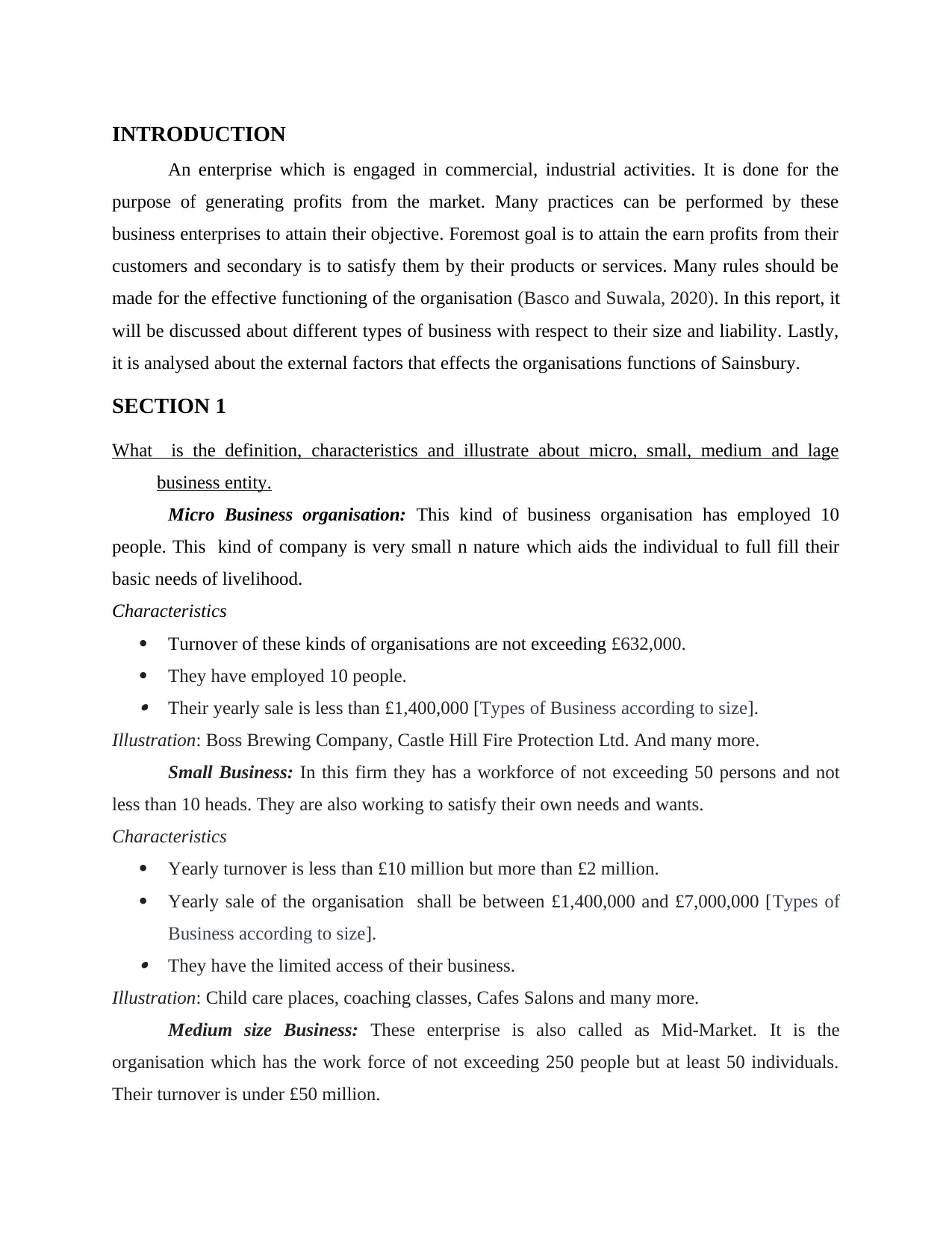
INTRODUCTION
An enterprise which is engaged in commercial, industrial activities. It is done for the
purpose of generating profits from the market. Many practices can be performed by these
business enterprises to attain their objective. Foremost goal is to attain the earn profits from their
customers and secondary is to satisfy them by their products or services. Many rules should be
made for the effective functioning of the organisation (Basco and Suwala, 2020). In this report, it
will be discussed about different types of business with respect to their size and liability. Lastly,
it is analysed about the external factors that effects the organisations functions of Sainsbury.
SECTION 1
What is the definition, characteristics and illustrate about micro, small, medium and lage
business entity.
Micro Business organisation: This kind of business organisation has employed 10
people. This kind of company is very small n nature which aids the individual to full fill their
basic needs of livelihood.
Characteristics
Turnover of these kinds of organisations are not exceeding £632,000.
They have employed 10 people. Their yearly sale is less than £1,400,000 [Types of Business according to size].
Illustration: Boss Brewing Company, Castle Hill Fire Protection Ltd. And many more.
Small Business: In this firm they has a workforce of not exceeding 50 persons and not
less than 10 heads. They are also working to satisfy their own needs and wants.
Characteristics
Yearly turnover is less than £10 million but more than £2 million.
Yearly sale of the organisation shall be between £1,400,000 and £7,000,000 [Types of
Business according to size]. They have the limited access of their business.
Illustration: Child care places, coaching classes, Cafes Salons and many more.
Medium size Business: These enterprise is also called as Mid-Market. It is the
organisation which has the work force of not exceeding 250 people but at least 50 individuals.
Their turnover is under £50 million.
An enterprise which is engaged in commercial, industrial activities. It is done for the
purpose of generating profits from the market. Many practices can be performed by these
business enterprises to attain their objective. Foremost goal is to attain the earn profits from their
customers and secondary is to satisfy them by their products or services. Many rules should be
made for the effective functioning of the organisation (Basco and Suwala, 2020). In this report, it
will be discussed about different types of business with respect to their size and liability. Lastly,
it is analysed about the external factors that effects the organisations functions of Sainsbury.
SECTION 1
What is the definition, characteristics and illustrate about micro, small, medium and lage
business entity.
Micro Business organisation: This kind of business organisation has employed 10
people. This kind of company is very small n nature which aids the individual to full fill their
basic needs of livelihood.
Characteristics
Turnover of these kinds of organisations are not exceeding £632,000.
They have employed 10 people. Their yearly sale is less than £1,400,000 [Types of Business according to size].
Illustration: Boss Brewing Company, Castle Hill Fire Protection Ltd. And many more.
Small Business: In this firm they has a workforce of not exceeding 50 persons and not
less than 10 heads. They are also working to satisfy their own needs and wants.
Characteristics
Yearly turnover is less than £10 million but more than £2 million.
Yearly sale of the organisation shall be between £1,400,000 and £7,000,000 [Types of
Business according to size]. They have the limited access of their business.
Illustration: Child care places, coaching classes, Cafes Salons and many more.
Medium size Business: These enterprise is also called as Mid-Market. It is the
organisation which has the work force of not exceeding 250 people but at least 50 individuals.
Their turnover is under £50 million.
⊘ This is a preview!⊘
Do you want full access?
Subscribe today to unlock all pages.

Trusted by 1+ million students worldwide
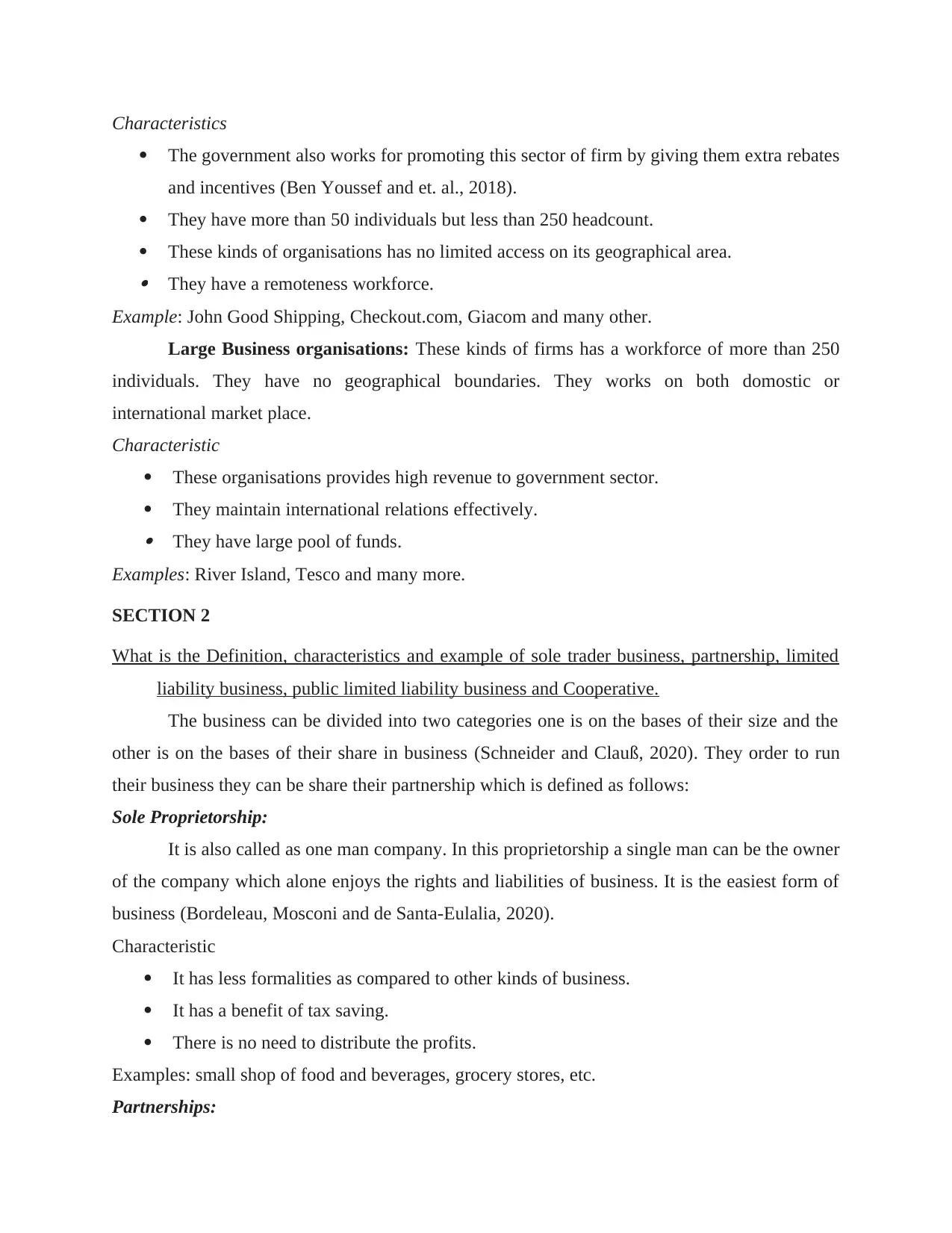
Characteristics
The government also works for promoting this sector of firm by giving them extra rebates
and incentives (Ben Youssef and et. al., 2018).
They have more than 50 individuals but less than 250 headcount.
These kinds of organisations has no limited access on its geographical area. They have a remoteness workforce.
Example: John Good Shipping, Checkout.com, Giacom and many other.
Large Business organisations: These kinds of firms has a workforce of more than 250
individuals. They have no geographical boundaries. They works on both domostic or
international market place.
Characteristic
These organisations provides high revenue to government sector.
They maintain international relations effectively. They have large pool of funds.
Examples: River Island, Tesco and many more.
SECTION 2
What is the Definition, characteristics and example of sole trader business, partnership, limited
liability business, public limited liability business and Cooperative.
The business can be divided into two categories one is on the bases of their size and the
other is on the bases of their share in business (Schneider and Clauß, 2020). They order to run
their business they can be share their partnership which is defined as follows:
Sole Proprietorship:
It is also called as one man company. In this proprietorship a single man can be the owner
of the company which alone enjoys the rights and liabilities of business. It is the easiest form of
business (Bordeleau, Mosconi and de Santa-Eulalia, 2020).
Characteristic
It has less formalities as compared to other kinds of business.
It has a benefit of tax saving.
There is no need to distribute the profits.
Examples: small shop of food and beverages, grocery stores, etc.
Partnerships:
The government also works for promoting this sector of firm by giving them extra rebates
and incentives (Ben Youssef and et. al., 2018).
They have more than 50 individuals but less than 250 headcount.
These kinds of organisations has no limited access on its geographical area. They have a remoteness workforce.
Example: John Good Shipping, Checkout.com, Giacom and many other.
Large Business organisations: These kinds of firms has a workforce of more than 250
individuals. They have no geographical boundaries. They works on both domostic or
international market place.
Characteristic
These organisations provides high revenue to government sector.
They maintain international relations effectively. They have large pool of funds.
Examples: River Island, Tesco and many more.
SECTION 2
What is the Definition, characteristics and example of sole trader business, partnership, limited
liability business, public limited liability business and Cooperative.
The business can be divided into two categories one is on the bases of their size and the
other is on the bases of their share in business (Schneider and Clauß, 2020). They order to run
their business they can be share their partnership which is defined as follows:
Sole Proprietorship:
It is also called as one man company. In this proprietorship a single man can be the owner
of the company which alone enjoys the rights and liabilities of business. It is the easiest form of
business (Bordeleau, Mosconi and de Santa-Eulalia, 2020).
Characteristic
It has less formalities as compared to other kinds of business.
It has a benefit of tax saving.
There is no need to distribute the profits.
Examples: small shop of food and beverages, grocery stores, etc.
Partnerships:
Paraphrase This Document
Need a fresh take? Get an instant paraphrase of this document with our AI Paraphraser
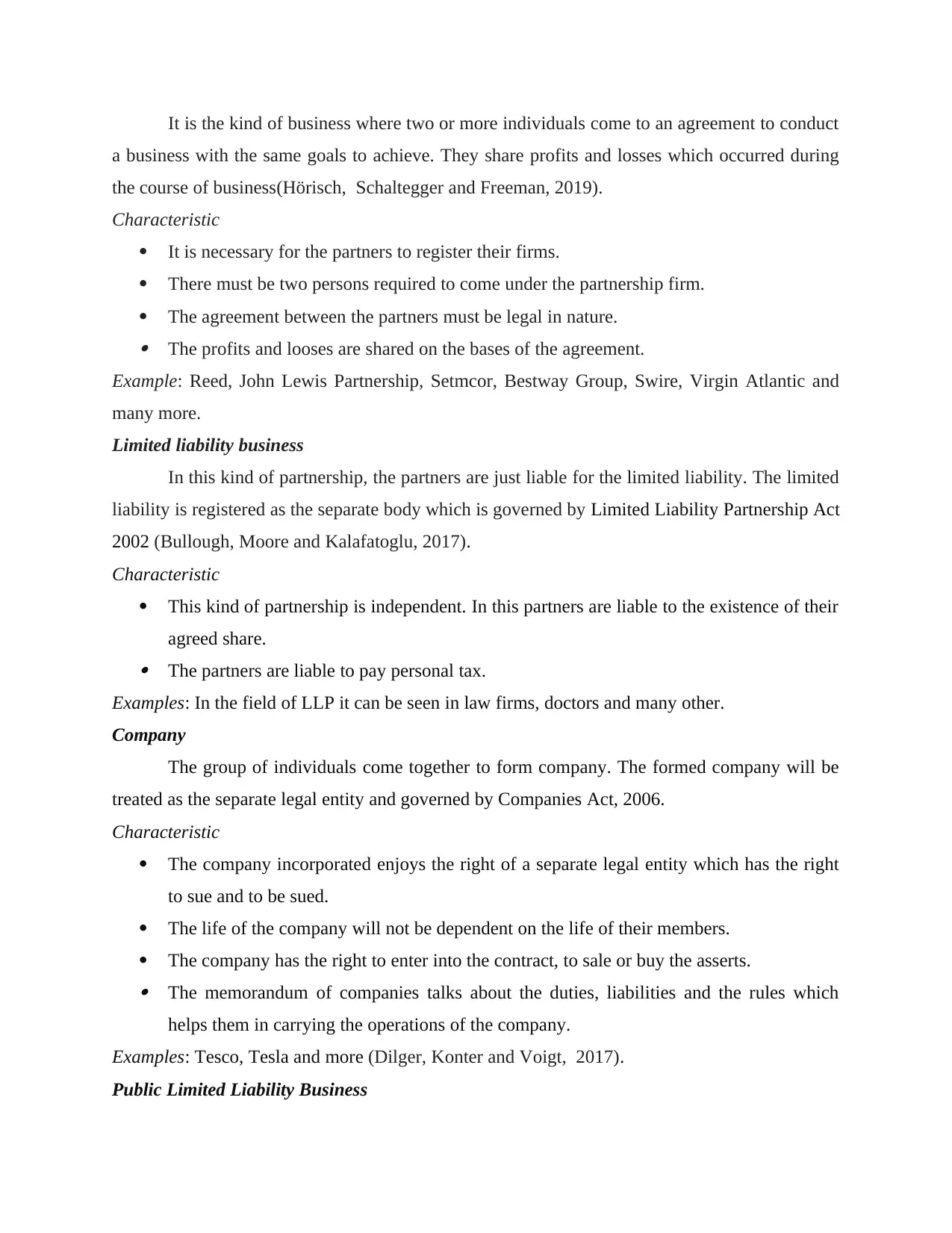
It is the kind of business where two or more individuals come to an agreement to conduct
a business with the same goals to achieve. They share profits and losses which occurred during
the course of business(Hörisch, Schaltegger and Freeman, 2019).
Characteristic
It is necessary for the partners to register their firms.
There must be two persons required to come under the partnership firm.
The agreement between the partners must be legal in nature. The profits and looses are shared on the bases of the agreement.
Example: Reed, John Lewis Partnership, Setmcor, Bestway Group, Swire, Virgin Atlantic and
many more.
Limited liability business
In this kind of partnership, the partners are just liable for the limited liability. The limited
liability is registered as the separate body which is governed by Limited Liability Partnership Act
2002 (Bullough, Moore and Kalafatoglu, 2017).
Characteristic
This kind of partnership is independent. In this partners are liable to the existence of their
agreed share. The partners are liable to pay personal tax.
Examples: In the field of LLP it can be seen in law firms, doctors and many other.
Company
The group of individuals come together to form company. The formed company will be
treated as the separate legal entity and governed by Companies Act, 2006.
Characteristic
The company incorporated enjoys the right of a separate legal entity which has the right
to sue and to be sued.
The life of the company will not be dependent on the life of their members.
The company has the right to enter into the contract, to sale or buy the asserts. The memorandum of companies talks about the duties, liabilities and the rules which
helps them in carrying the operations of the company.
Examples: Tesco, Tesla and more (Dilger, Konter and Voigt, 2017).
Public Limited Liability Business
a business with the same goals to achieve. They share profits and losses which occurred during
the course of business(Hörisch, Schaltegger and Freeman, 2019).
Characteristic
It is necessary for the partners to register their firms.
There must be two persons required to come under the partnership firm.
The agreement between the partners must be legal in nature. The profits and looses are shared on the bases of the agreement.
Example: Reed, John Lewis Partnership, Setmcor, Bestway Group, Swire, Virgin Atlantic and
many more.
Limited liability business
In this kind of partnership, the partners are just liable for the limited liability. The limited
liability is registered as the separate body which is governed by Limited Liability Partnership Act
2002 (Bullough, Moore and Kalafatoglu, 2017).
Characteristic
This kind of partnership is independent. In this partners are liable to the existence of their
agreed share. The partners are liable to pay personal tax.
Examples: In the field of LLP it can be seen in law firms, doctors and many other.
Company
The group of individuals come together to form company. The formed company will be
treated as the separate legal entity and governed by Companies Act, 2006.
Characteristic
The company incorporated enjoys the right of a separate legal entity which has the right
to sue and to be sued.
The life of the company will not be dependent on the life of their members.
The company has the right to enter into the contract, to sale or buy the asserts. The memorandum of companies talks about the duties, liabilities and the rules which
helps them in carrying the operations of the company.
Examples: Tesco, Tesla and more (Dilger, Konter and Voigt, 2017).
Public Limited Liability Business
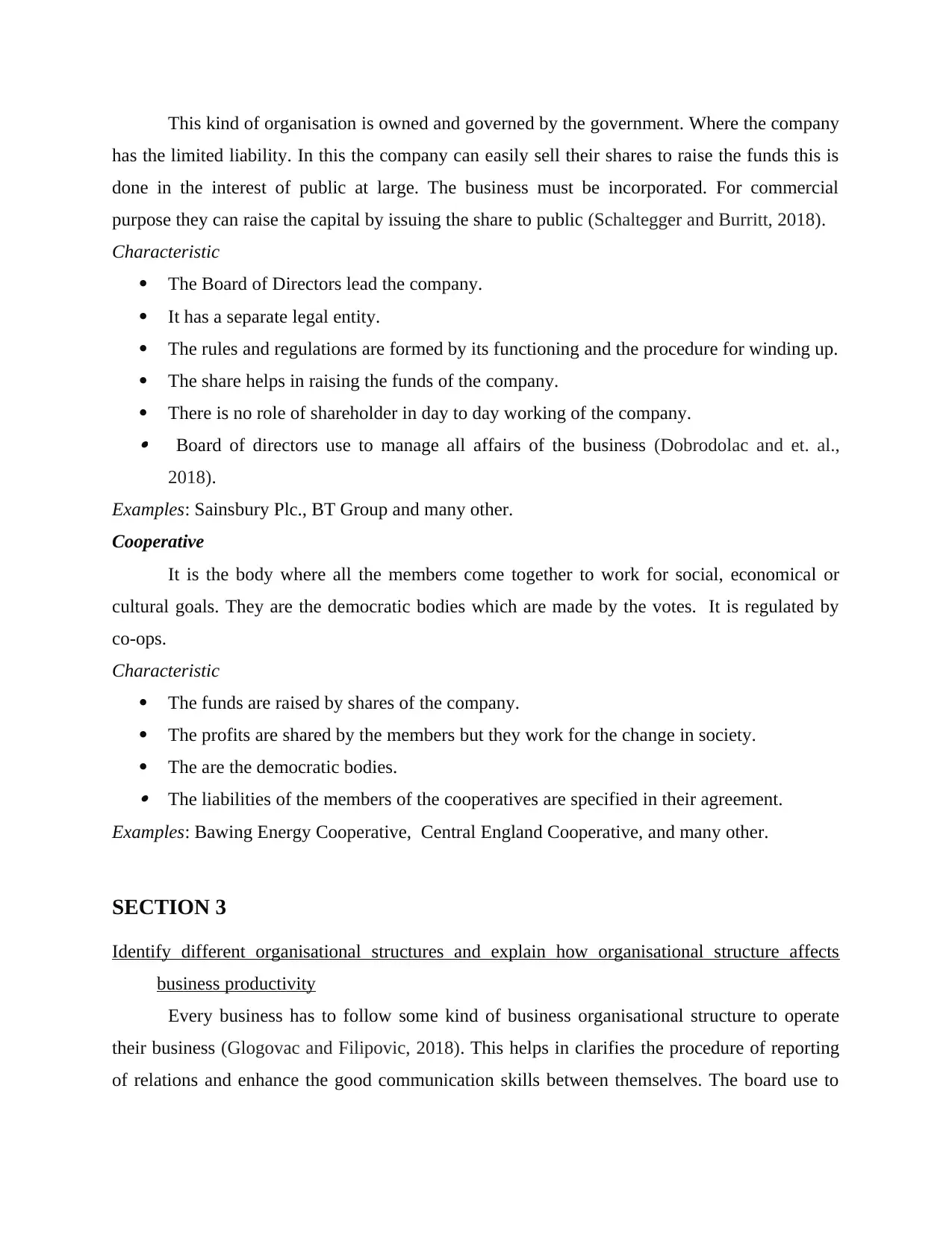
This kind of organisation is owned and governed by the government. Where the company
has the limited liability. In this the company can easily sell their shares to raise the funds this is
done in the interest of public at large. The business must be incorporated. For commercial
purpose they can raise the capital by issuing the share to public (Schaltegger and Burritt, 2018).
Characteristic
The Board of Directors lead the company.
It has a separate legal entity.
The rules and regulations are formed by its functioning and the procedure for winding up.
The share helps in raising the funds of the company.
There is no role of shareholder in day to day working of the company. Board of directors use to manage all affairs of the business (Dobrodolac and et. al.,
2018).
Examples: Sainsbury Plc., BT Group and many other.
Cooperative
It is the body where all the members come together to work for social, economical or
cultural goals. They are the democratic bodies which are made by the votes. It is regulated by
co-ops.
Characteristic
The funds are raised by shares of the company.
The profits are shared by the members but they work for the change in society.
The are the democratic bodies. The liabilities of the members of the cooperatives are specified in their agreement.
Examples: Bawing Energy Cooperative, Central England Cooperative, and many other.
SECTION 3
Identify different organisational structures and explain how organisational structure affects
business productivity
Every business has to follow some kind of business organisational structure to operate
their business (Glogovac and Filipovic, 2018). This helps in clarifies the procedure of reporting
of relations and enhance the good communication skills between themselves. The board use to
has the limited liability. In this the company can easily sell their shares to raise the funds this is
done in the interest of public at large. The business must be incorporated. For commercial
purpose they can raise the capital by issuing the share to public (Schaltegger and Burritt, 2018).
Characteristic
The Board of Directors lead the company.
It has a separate legal entity.
The rules and regulations are formed by its functioning and the procedure for winding up.
The share helps in raising the funds of the company.
There is no role of shareholder in day to day working of the company. Board of directors use to manage all affairs of the business (Dobrodolac and et. al.,
2018).
Examples: Sainsbury Plc., BT Group and many other.
Cooperative
It is the body where all the members come together to work for social, economical or
cultural goals. They are the democratic bodies which are made by the votes. It is regulated by
co-ops.
Characteristic
The funds are raised by shares of the company.
The profits are shared by the members but they work for the change in society.
The are the democratic bodies. The liabilities of the members of the cooperatives are specified in their agreement.
Examples: Bawing Energy Cooperative, Central England Cooperative, and many other.
SECTION 3
Identify different organisational structures and explain how organisational structure affects
business productivity
Every business has to follow some kind of business organisational structure to operate
their business (Glogovac and Filipovic, 2018). This helps in clarifies the procedure of reporting
of relations and enhance the good communication skills between themselves. The board use to
⊘ This is a preview!⊘
Do you want full access?
Subscribe today to unlock all pages.

Trusted by 1+ million students worldwide
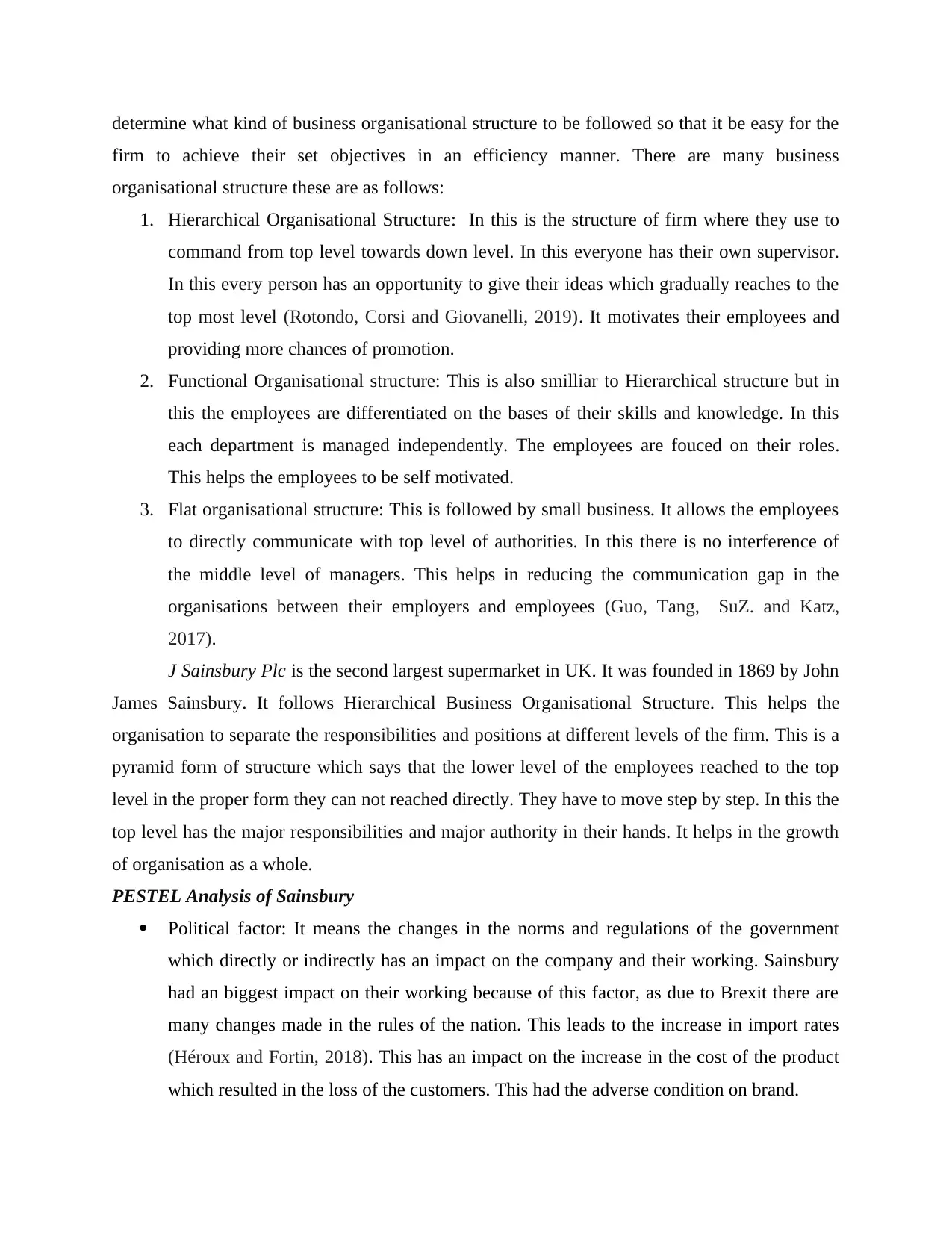
determine what kind of business organisational structure to be followed so that it be easy for the
firm to achieve their set objectives in an efficiency manner. There are many business
organisational structure these are as follows:
1. Hierarchical Organisational Structure: In this is the structure of firm where they use to
command from top level towards down level. In this everyone has their own supervisor.
In this every person has an opportunity to give their ideas which gradually reaches to the
top most level (Rotondo, Corsi and Giovanelli, 2019). It motivates their employees and
providing more chances of promotion.
2. Functional Organisational structure: This is also smilliar to Hierarchical structure but in
this the employees are differentiated on the bases of their skills and knowledge. In this
each department is managed independently. The employees are fouced on their roles.
This helps the employees to be self motivated.
3. Flat organisational structure: This is followed by small business. It allows the employees
to directly communicate with top level of authorities. In this there is no interference of
the middle level of managers. This helps in reducing the communication gap in the
organisations between their employers and employees (Guo, Tang, SuZ. and Katz,
2017).
J Sainsbury Plc is the second largest supermarket in UK. It was founded in 1869 by John
James Sainsbury. It follows Hierarchical Business Organisational Structure. This helps the
organisation to separate the responsibilities and positions at different levels of the firm. This is a
pyramid form of structure which says that the lower level of the employees reached to the top
level in the proper form they can not reached directly. They have to move step by step. In this the
top level has the major responsibilities and major authority in their hands. It helps in the growth
of organisation as a whole.
PESTEL Analysis of Sainsbury
Political factor: It means the changes in the norms and regulations of the government
which directly or indirectly has an impact on the company and their working. Sainsbury
had an biggest impact on their working because of this factor, as due to Brexit there are
many changes made in the rules of the nation. This leads to the increase in import rates
(Héroux and Fortin, 2018). This has an impact on the increase in the cost of the product
which resulted in the loss of the customers. This had the adverse condition on brand.
firm to achieve their set objectives in an efficiency manner. There are many business
organisational structure these are as follows:
1. Hierarchical Organisational Structure: In this is the structure of firm where they use to
command from top level towards down level. In this everyone has their own supervisor.
In this every person has an opportunity to give their ideas which gradually reaches to the
top most level (Rotondo, Corsi and Giovanelli, 2019). It motivates their employees and
providing more chances of promotion.
2. Functional Organisational structure: This is also smilliar to Hierarchical structure but in
this the employees are differentiated on the bases of their skills and knowledge. In this
each department is managed independently. The employees are fouced on their roles.
This helps the employees to be self motivated.
3. Flat organisational structure: This is followed by small business. It allows the employees
to directly communicate with top level of authorities. In this there is no interference of
the middle level of managers. This helps in reducing the communication gap in the
organisations between their employers and employees (Guo, Tang, SuZ. and Katz,
2017).
J Sainsbury Plc is the second largest supermarket in UK. It was founded in 1869 by John
James Sainsbury. It follows Hierarchical Business Organisational Structure. This helps the
organisation to separate the responsibilities and positions at different levels of the firm. This is a
pyramid form of structure which says that the lower level of the employees reached to the top
level in the proper form they can not reached directly. They have to move step by step. In this the
top level has the major responsibilities and major authority in their hands. It helps in the growth
of organisation as a whole.
PESTEL Analysis of Sainsbury
Political factor: It means the changes in the norms and regulations of the government
which directly or indirectly has an impact on the company and their working. Sainsbury
had an biggest impact on their working because of this factor, as due to Brexit there are
many changes made in the rules of the nation. This leads to the increase in import rates
(Héroux and Fortin, 2018). This has an impact on the increase in the cost of the product
which resulted in the loss of the customers. This had the adverse condition on brand.
Paraphrase This Document
Need a fresh take? Get an instant paraphrase of this document with our AI Paraphraser
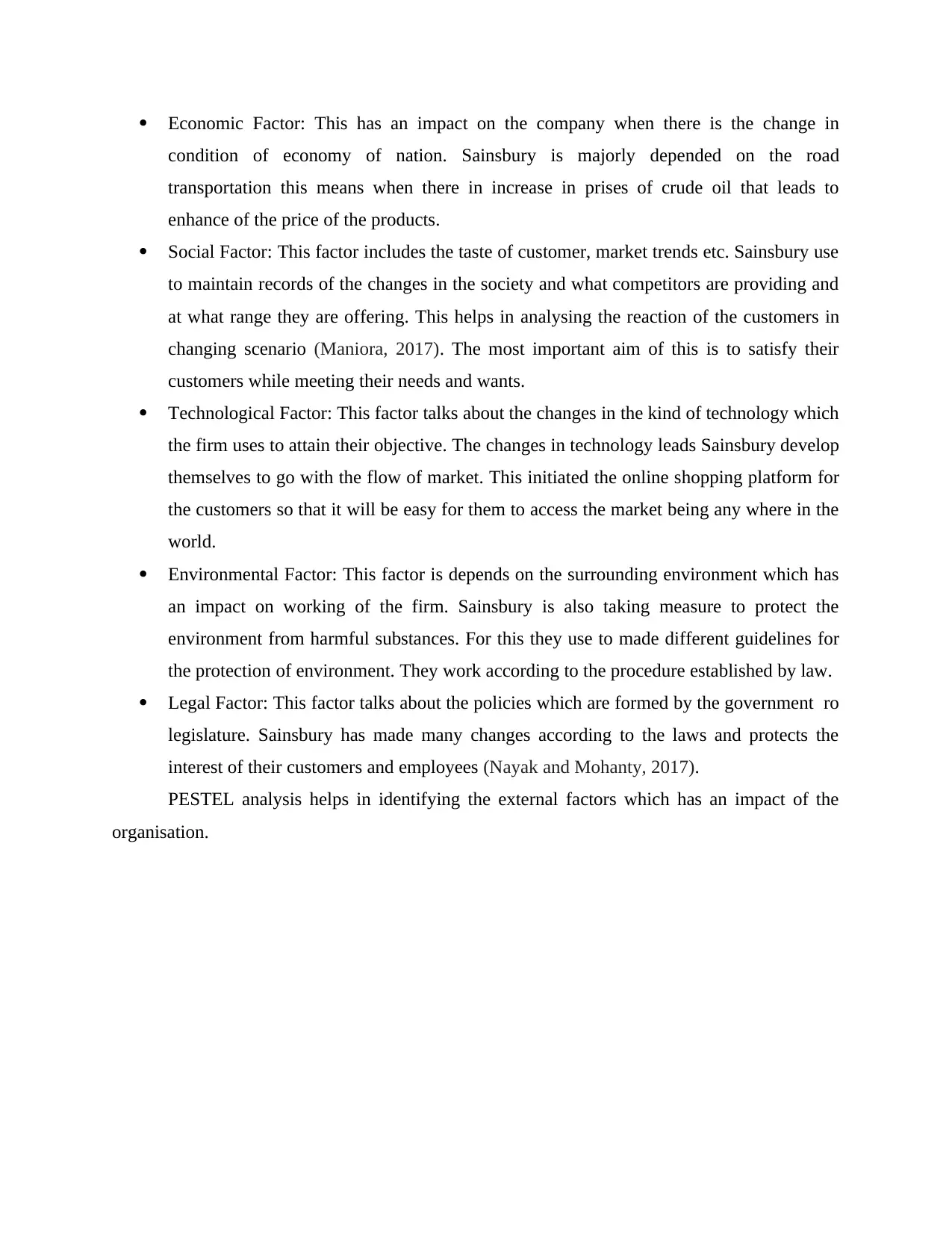
Economic Factor: This has an impact on the company when there is the change in
condition of economy of nation. Sainsbury is majorly depended on the road
transportation this means when there in increase in prises of crude oil that leads to
enhance of the price of the products.
Social Factor: This factor includes the taste of customer, market trends etc. Sainsbury use
to maintain records of the changes in the society and what competitors are providing and
at what range they are offering. This helps in analysing the reaction of the customers in
changing scenario (Maniora, 2017). The most important aim of this is to satisfy their
customers while meeting their needs and wants.
Technological Factor: This factor talks about the changes in the kind of technology which
the firm uses to attain their objective. The changes in technology leads Sainsbury develop
themselves to go with the flow of market. This initiated the online shopping platform for
the customers so that it will be easy for them to access the market being any where in the
world.
Environmental Factor: This factor is depends on the surrounding environment which has
an impact on working of the firm. Sainsbury is also taking measure to protect the
environment from harmful substances. For this they use to made different guidelines for
the protection of environment. They work according to the procedure established by law.
Legal Factor: This factor talks about the policies which are formed by the government ro
legislature. Sainsbury has made many changes according to the laws and protects the
interest of their customers and employees (Nayak and Mohanty, 2017).
PESTEL analysis helps in identifying the external factors which has an impact of the
organisation.
condition of economy of nation. Sainsbury is majorly depended on the road
transportation this means when there in increase in prises of crude oil that leads to
enhance of the price of the products.
Social Factor: This factor includes the taste of customer, market trends etc. Sainsbury use
to maintain records of the changes in the society and what competitors are providing and
at what range they are offering. This helps in analysing the reaction of the customers in
changing scenario (Maniora, 2017). The most important aim of this is to satisfy their
customers while meeting their needs and wants.
Technological Factor: This factor talks about the changes in the kind of technology which
the firm uses to attain their objective. The changes in technology leads Sainsbury develop
themselves to go with the flow of market. This initiated the online shopping platform for
the customers so that it will be easy for them to access the market being any where in the
world.
Environmental Factor: This factor is depends on the surrounding environment which has
an impact on working of the firm. Sainsbury is also taking measure to protect the
environment from harmful substances. For this they use to made different guidelines for
the protection of environment. They work according to the procedure established by law.
Legal Factor: This factor talks about the policies which are formed by the government ro
legislature. Sainsbury has made many changes according to the laws and protects the
interest of their customers and employees (Nayak and Mohanty, 2017).
PESTEL analysis helps in identifying the external factors which has an impact of the
organisation.
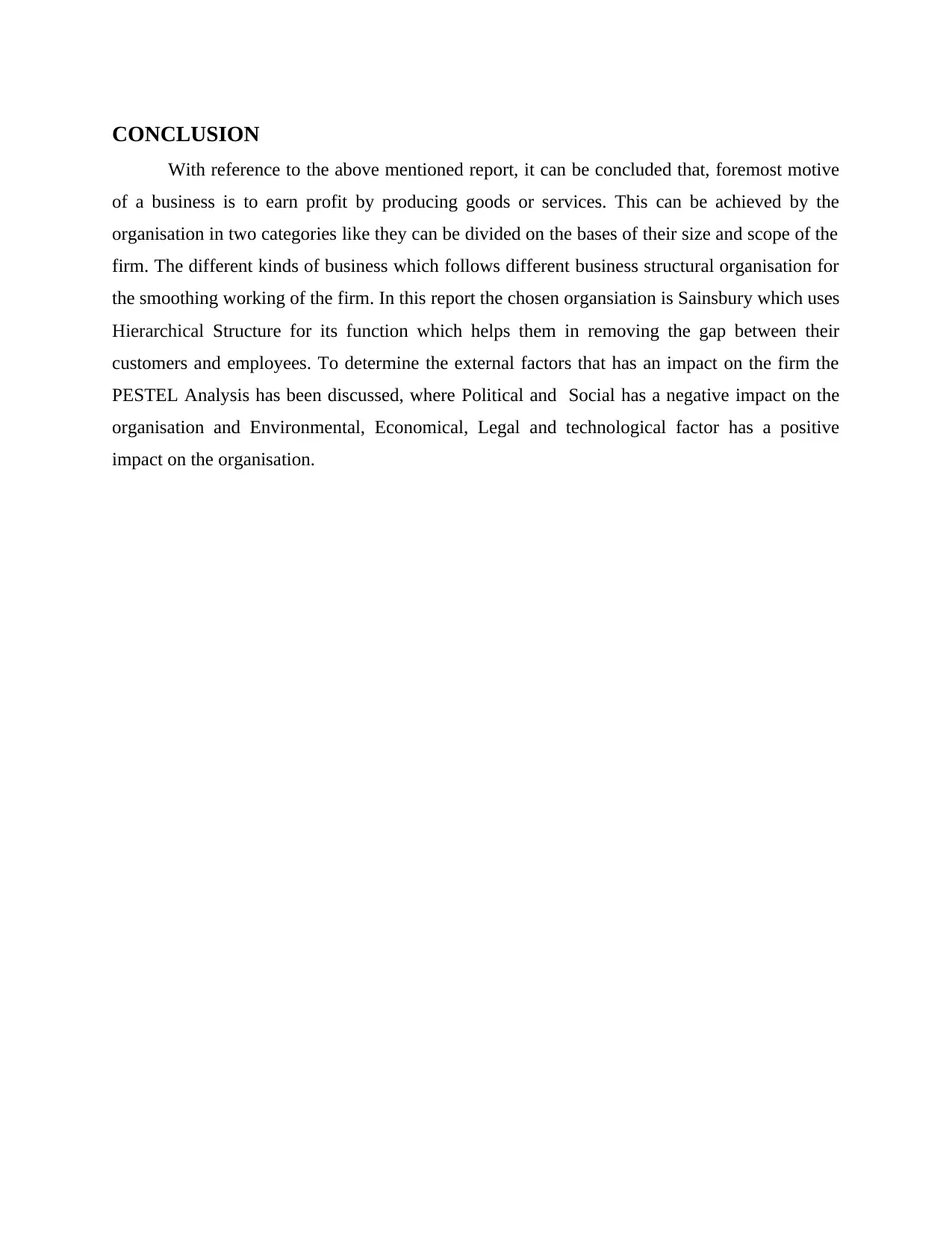
CONCLUSION
With reference to the above mentioned report, it can be concluded that, foremost motive
of a business is to earn profit by producing goods or services. This can be achieved by the
organisation in two categories like they can be divided on the bases of their size and scope of the
firm. The different kinds of business which follows different business structural organisation for
the smoothing working of the firm. In this report the chosen organsiation is Sainsbury which uses
Hierarchical Structure for its function which helps them in removing the gap between their
customers and employees. To determine the external factors that has an impact on the firm the
PESTEL Analysis has been discussed, where Political and Social has a negative impact on the
organisation and Environmental, Economical, Legal and technological factor has a positive
impact on the organisation.
With reference to the above mentioned report, it can be concluded that, foremost motive
of a business is to earn profit by producing goods or services. This can be achieved by the
organisation in two categories like they can be divided on the bases of their size and scope of the
firm. The different kinds of business which follows different business structural organisation for
the smoothing working of the firm. In this report the chosen organsiation is Sainsbury which uses
Hierarchical Structure for its function which helps them in removing the gap between their
customers and employees. To determine the external factors that has an impact on the firm the
PESTEL Analysis has been discussed, where Political and Social has a negative impact on the
organisation and Environmental, Economical, Legal and technological factor has a positive
impact on the organisation.
⊘ This is a preview!⊘
Do you want full access?
Subscribe today to unlock all pages.

Trusted by 1+ million students worldwide
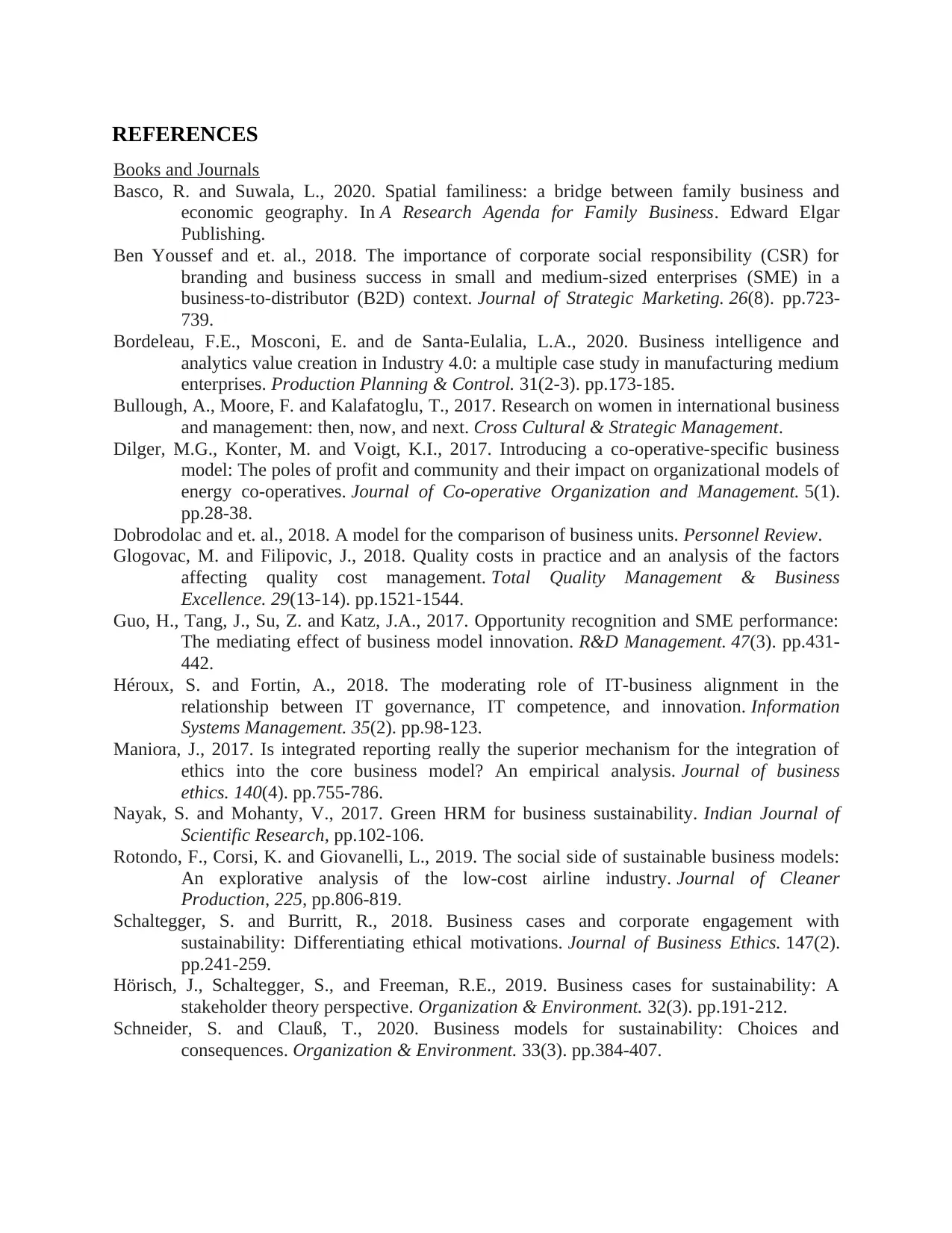
REFERENCES
Books and Journals
Basco, R. and Suwala, L., 2020. Spatial familiness: a bridge between family business and
economic geography. In A Research Agenda for Family Business. Edward Elgar
Publishing.
Ben Youssef and et. al., 2018. The importance of corporate social responsibility (CSR) for
branding and business success in small and medium-sized enterprises (SME) in a
business-to-distributor (B2D) context. Journal of Strategic Marketing. 26(8). pp.723-
739.
Bordeleau, F.E., Mosconi, E. and de Santa-Eulalia, L.A., 2020. Business intelligence and
analytics value creation in Industry 4.0: a multiple case study in manufacturing medium
enterprises. Production Planning & Control. 31(2-3). pp.173-185.
Bullough, A., Moore, F. and Kalafatoglu, T., 2017. Research on women in international business
and management: then, now, and next. Cross Cultural & Strategic Management.
Dilger, M.G., Konter, M. and Voigt, K.I., 2017. Introducing a co-operative-specific business
model: The poles of profit and community and their impact on organizational models of
energy co-operatives. Journal of Co-operative Organization and Management. 5(1).
pp.28-38.
Dobrodolac and et. al., 2018. A model for the comparison of business units. Personnel Review.
Glogovac, M. and Filipovic, J., 2018. Quality costs in practice and an analysis of the factors
affecting quality cost management. Total Quality Management & Business
Excellence. 29(13-14). pp.1521-1544.
Guo, H., Tang, J., Su, Z. and Katz, J.A., 2017. Opportunity recognition and SME performance:
The mediating effect of business model innovation. R&D Management. 47(3). pp.431-
442.
Héroux, S. and Fortin, A., 2018. The moderating role of IT-business alignment in the
relationship between IT governance, IT competence, and innovation. Information
Systems Management. 35(2). pp.98-123.
Maniora, J., 2017. Is integrated reporting really the superior mechanism for the integration of
ethics into the core business model? An empirical analysis. Journal of business
ethics. 140(4). pp.755-786.
Nayak, S. and Mohanty, V., 2017. Green HRM for business sustainability. Indian Journal of
Scientific Research, pp.102-106.
Rotondo, F., Corsi, K. and Giovanelli, L., 2019. The social side of sustainable business models:
An explorative analysis of the low-cost airline industry. Journal of Cleaner
Production, 225, pp.806-819.
Schaltegger, S. and Burritt, R., 2018. Business cases and corporate engagement with
sustainability: Differentiating ethical motivations. Journal of Business Ethics. 147(2).
pp.241-259.
Hörisch, J., Schaltegger, S., and Freeman, R.E., 2019. Business cases for sustainability: A
stakeholder theory perspective. Organization & Environment. 32(3). pp.191-212.
Schneider, S. and Clauß, T., 2020. Business models for sustainability: Choices and
consequences. Organization & Environment. 33(3). pp.384-407.
Books and Journals
Basco, R. and Suwala, L., 2020. Spatial familiness: a bridge between family business and
economic geography. In A Research Agenda for Family Business. Edward Elgar
Publishing.
Ben Youssef and et. al., 2018. The importance of corporate social responsibility (CSR) for
branding and business success in small and medium-sized enterprises (SME) in a
business-to-distributor (B2D) context. Journal of Strategic Marketing. 26(8). pp.723-
739.
Bordeleau, F.E., Mosconi, E. and de Santa-Eulalia, L.A., 2020. Business intelligence and
analytics value creation in Industry 4.0: a multiple case study in manufacturing medium
enterprises. Production Planning & Control. 31(2-3). pp.173-185.
Bullough, A., Moore, F. and Kalafatoglu, T., 2017. Research on women in international business
and management: then, now, and next. Cross Cultural & Strategic Management.
Dilger, M.G., Konter, M. and Voigt, K.I., 2017. Introducing a co-operative-specific business
model: The poles of profit and community and their impact on organizational models of
energy co-operatives. Journal of Co-operative Organization and Management. 5(1).
pp.28-38.
Dobrodolac and et. al., 2018. A model for the comparison of business units. Personnel Review.
Glogovac, M. and Filipovic, J., 2018. Quality costs in practice and an analysis of the factors
affecting quality cost management. Total Quality Management & Business
Excellence. 29(13-14). pp.1521-1544.
Guo, H., Tang, J., Su, Z. and Katz, J.A., 2017. Opportunity recognition and SME performance:
The mediating effect of business model innovation. R&D Management. 47(3). pp.431-
442.
Héroux, S. and Fortin, A., 2018. The moderating role of IT-business alignment in the
relationship between IT governance, IT competence, and innovation. Information
Systems Management. 35(2). pp.98-123.
Maniora, J., 2017. Is integrated reporting really the superior mechanism for the integration of
ethics into the core business model? An empirical analysis. Journal of business
ethics. 140(4). pp.755-786.
Nayak, S. and Mohanty, V., 2017. Green HRM for business sustainability. Indian Journal of
Scientific Research, pp.102-106.
Rotondo, F., Corsi, K. and Giovanelli, L., 2019. The social side of sustainable business models:
An explorative analysis of the low-cost airline industry. Journal of Cleaner
Production, 225, pp.806-819.
Schaltegger, S. and Burritt, R., 2018. Business cases and corporate engagement with
sustainability: Differentiating ethical motivations. Journal of Business Ethics. 147(2).
pp.241-259.
Hörisch, J., Schaltegger, S., and Freeman, R.E., 2019. Business cases for sustainability: A
stakeholder theory perspective. Organization & Environment. 32(3). pp.191-212.
Schneider, S. and Clauß, T., 2020. Business models for sustainability: Choices and
consequences. Organization & Environment. 33(3). pp.384-407.
1 out of 10
Related Documents
Your All-in-One AI-Powered Toolkit for Academic Success.
+13062052269
info@desklib.com
Available 24*7 on WhatsApp / Email
![[object Object]](/_next/static/media/star-bottom.7253800d.svg)
Unlock your academic potential
Copyright © 2020–2025 A2Z Services. All Rights Reserved. Developed and managed by ZUCOL.





